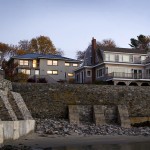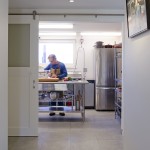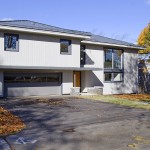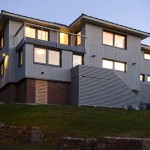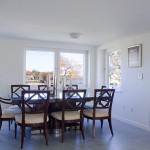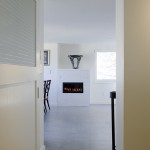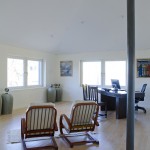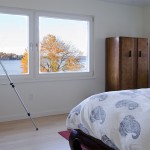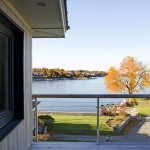Maiden Cove Deep Energy Retrofit
Project Name
This project is one of the most quietly ambitious renovation projects our office has completed. Could a 1960’s contemporary be revived and rejuvenated to meet the Passive House EnerPHit renovation standard without changing the building form? Could modern conservation goals sit well with mid-century modernist design?
Our client had come to love the odd duck 60’s hip roofed contemporary house that sat at the top of the hill overlooking the Atlantic at Maiden Cove, even though its style didn’t match the rest of the older houses in the neighborhood. We looked to mid-century modernism as a guide to try and design a serene elegance, perhaps the “pin striped suit” of the neighborhood.
RESPONSE
The project became a series of surgical interventions: a delicate widening of the southern windows, removal of a floor section to create a soaring double height space, full window replacement with triple glazed tilt-turn R-8 windows, adding a full heat recovery ventilation system and air source heat pumps to radically drop the energy consumption, all without calling too much attention to oneself in a private oceanfront neighborhood.
At completion, the project reached an air tightness standard of 0.67 ACH50, astounding for a renovation project. It met the Primary Energy goals of the Passive House certification standard at 31.26 kBTU/ SF / year and achieved an EUI of 13.
The project shows that our existing buildings can be reused, repurposed and reclaimed for many generations with proper construction techniques. This building made it though its first half century already, and we expect it to be able to last for another century without blinking now that its enclosure has been modernized and has achieved permanent affordability in terms of energy bills.
RENOVATION
Maine is a place of old buildings and fully built out neighborhoods, so renovation & demolition is a constant component of our waterfront neighborhoods. Unlike so many of the tear-downs we see in these neighborhoods, our clients wanted to prove that their existing house was “almost there”, and with skillful renovation could be made to work well for modern times without needed to throw a building away in a dumpsters.
Our renovation did not increase the size of the existing building and expand the building footprint, but instead carefully maximized the existing space, creating flow where there once was as series of discrete rooms and odd spatial relationships. We removed the split level entrance to allow the upper level kitchen to descend to the proper level and provide views out to the ocean from all rooms. Sleeping rooms moved up to the upper floors for privacy and water views.
Exterior insulation can be thick and bulky when added onto a building and it can end up feeling like an overstuffed chair, so we pushed ourselves to design delicate thin architectural details that brought harmony and grace to 12″ thick walls and 5″ wide window frames.
The renovation was unique in that it sought to be a “quiet” project when completed, and while the owners had ambitious architectural and technical goals, they did not want to stand out and attract undue attention to themselves or the house once complete.
Vertical cedar siding harmonizes with the cedar shingles of many of the neighbors, the roof pitch and building height remains unchanged, even the window openings stay in place except for the grand window wall which soaks in the southern light and sun. The project brings waterfront design traditions forward in a sustainable way.
WATER CONSERVATION
Careful detailing is visible throughout to manage tough waterfront storms.
– Roof overhangs keep water off siding
– Tough metal window sills steer drainage out away from traditional leak spots
– Triple glazed windows are placed in the middle of the wall away from the drip line
– No metals which can corrode are used on the exterior of the building
– Operable windows open on all sides to allow cross ventilation off the ocean
All fixtures are low-flow.
The natural gas instant water heater uses 60% less Primary Energy than an electric water heater of the same capacity.
SUSTAINABLE LANDSCAPE
Lot coverage was not increased, since permeable soils are at a premium on the rocky coast of Maine. Careful landscaping allowed removal of asphalt paving.
The stone walkway at the front is cleverly laid out as a Bar Code spelling out the owners’ names, perhaps for future aerial viewers to decipher from their pocket drones.
ENERGY EFFICIENT
The project attempted to minimize energy use at every opportunity, with a modeled performance of only EUI 13.
It was designed to meet the Passive House EnerPHit standard, and it succeeded at 2 out of the 3 metrics required for Certification. It uses only 31 kBTU / SF / year total Primary Energy per the Passive House Standard (maximum 38). It also smashed the EnerPHit air tightness standard by 40%, reading a blower door test reading of 0.67 ACH50.
Projected heating costs for this house are under $600 / year, a reduction of 80% from the previous heating costs.
The client has installed a full building energy monitoring system in the project to understand at a deep level the workings of their building. We expect to get reports of its activity regularly as the years go on.

